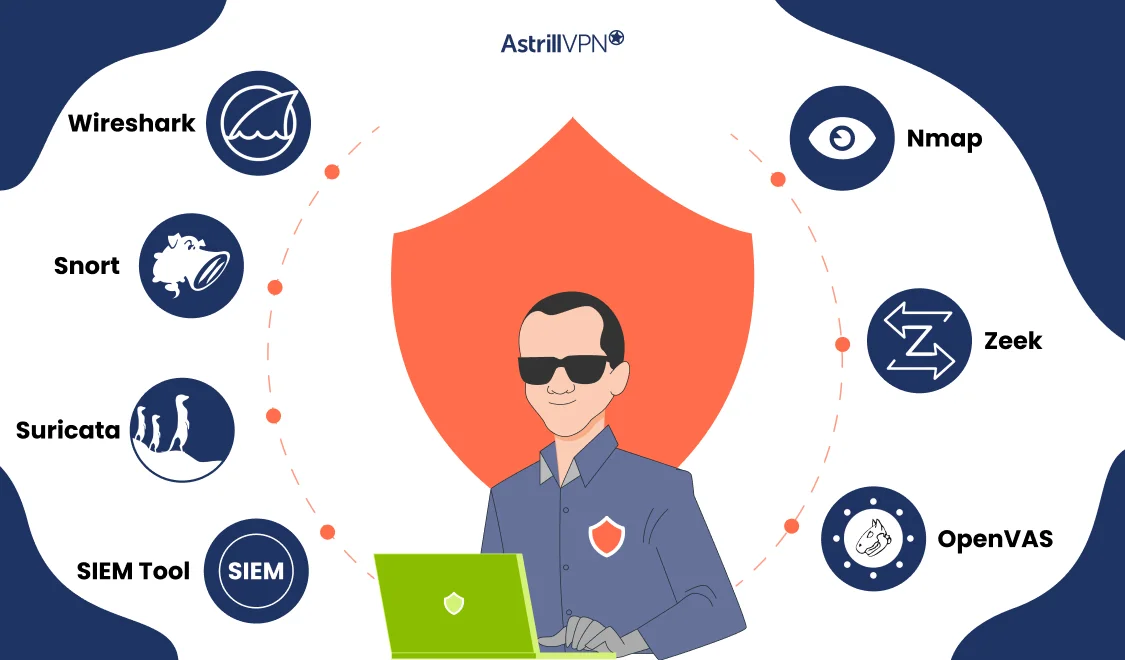Network Security Monitoring: Safeguarding Your Digital Ecosystem

Bisma Farrukh

In today’s interconnected world, your organization’s digital infrastructure is both its greatest asset and its most vulnerable target. As cyber threats evolve and multiply, safeguarding your network has become more critical than ever. By implementing robust monitoring protocols, you can stay one step ahead of malicious actors, protect sensitive information, and maintain the trust of your stakeholders. Discover how network security monitoring can fortify your digital ecosystem against an ever-changing threat landscape.
Table of Contents
What is a Network Security Monitoring?
Network Security Monitoring (NSM) is a comprehensive approach to safeguarding your digital infrastructure. It involves the continuous collection, analysis, and interpretation of network data to detect and respond to potential security threats. Network Security Monitoring systems act as vigilant guardians, constantly observing network traffic patterns, user behaviors, and system activities.
These systems employ various tools and techniques, including intrusion detection systems (IDS), firewalls, and log analyzers, to identify anomalies that may indicate malicious activities. By providing real-time visibility into network operations, NSM enables organizations to swiftly detect and mitigate security breaches, unauthorized access attempts, and other cyber threats.
What is NSM used for?
Network Security Monitoring (NSM) is a crucial defense mechanism for your digital infrastructure. Its primary function is to detect and respond to potential security threats in real-time. By continuously analyzing network traffic, NSM helps identify suspicious activities, malware infections, and unauthorized access attempts.
NSM is also instrumental in maintaining compliance with industry regulations and standards. It provides valuable insights into network performance, enabling IT teams to optimize resource allocation and troubleshoot issues efficiently. Additionally, NSM plays a vital role in forensic analysis, allowing organizations to investigate security incidents and improve their overall security posture.
By leveraging NSM, businesses can proactively safeguard their sensitive data, protect against cyber attacks, and ensure the smooth operation of their digital ecosystem.
Benefits of Network Security Monitoring
Network security monitoring offers numerous advantages for organizations seeking to safeguard their digital assets.
- By implementing robust monitoring systems, you can proactively identify and respond to potential threats before they escalate into major security incidents. This vigilance allows for real-time threat detection, enabling your team to swiftly neutralize risks and minimize potential damage.
- Furthermore, network security monitoring provides valuable insights into network performance and user behavior patterns. These analytics can help you optimize your infrastructure, enhance overall efficiency, and make data-driven decisions to strengthen your security posture.
- Additionally, comprehensive monitoring aids in regulatory compliance, ensuring your organization meets industry standards and legal requirements for data protection.
By constantly monitoring your network, you create a deterrent effect against malicious actors, reducing the likelihood of successful cyberattacks and fostering a culture of security awareness within your organization.
Read Also: Understanding Network Security Threats: Types, Risks and Detection
Key Principles of Effective Network Security Monitoring
Implementing robust network security monitoring requires adherence to several crucial principles.
- First, continuous monitoring is essential. Your system should vigilantly observe network traffic 24/7, detecting anomalies in real time.
- Secondly, employ a layered approach, combining various tools and techniques to create a comprehensive defense strategy. This might include firewalls, intrusion detection systems, and log analysis tools.
- Data correlation is another vital principle. By connecting information from multiple sources, you can identify complex threats that might otherwise go unnoticed.
- Additionally, prioritize automated responses to swiftly address potential security breaches. This rapid reaction time can significantly mitigate damage from cyber attacks.
- Lastly, remember that effective monitoring is an ongoing process. Regularly update and fine-tune your monitoring tools and protocols to stay ahead of evolving threats in the ever-changing digital landscape.
Leveraging Network Security Monitoring Tools
Network security monitoring software and tools are essential for safeguarding your digital ecosystem. These powerful solutions provide real-time visibility into network traffic, helping you detect and respond to potential threats swiftly. By implementing robust monitoring tools, you can:
- Identify suspicious activities and anomalies
- Track user behavior and access patterns
- Analyze network performance metrics
Modern monitoring platforms often incorporate machine learning and artificial intelligence to enhance threat detection capabilities. These advanced features enable you to stay ahead of evolving cybersecurity risks and minimize false positives.
Network security monitoring tools and software are essential components of a robust cybersecurity infrastructure, helping organizations detect and respond to potential threats in real time. Here are some popular network security monitoring tools and software widely used in the industry:

1. Wireshark
Wireshark is a widely used network protocol analyzer that captures and displays data traveling back and forth on a network in real-time. It helps troubleshoot network issues and identify potential security threats.
2. Snort
Snort is an open-source network intrusion detection and prevention system that analyzes network traffic in real time for malicious activity. It can generate alerts for suspicious behavior and help block potential threats.
3. Suricata
Suricata is another open-source intrusion detection and prevention system that provides real-time traffic analysis and threat detection capabilities. It offers high-performance network security monitoring features.
4. Security Information and Event Management (SIEM) Tools
SIEM tools like Splunk, IBM QRadar, and ArcSight are used for centralized logging, analysis, and correlation of security events across an organization’s network. They help in detecting and responding to security incidents effectively.
5. Nmap
Nmap is a powerful network scanning tool for network discovery and security auditing. It can detect open ports, services running on network devices, and potential vulnerabilities.
6. Zeek (formerly known as Bro)
Zeek is a powerful network analysis framework that provides detailed insights into network activity. It can help monitor network traffic, detect anomalies, and analyze security events.
7. OpenVAS
OpenVAS is an open-source vulnerability scanner that helps in identifying security issues and weaknesses in network devices, servers, and applications. It can be used for proactive security monitoring and risk assessment.
By leveraging these network security monitoring tools and software, organizations can strengthen their cybersecurity posture, proactively identify potential threats, and respond to incidents swiftly to mitigate risks effectively.
Optimizing Your Network Security Monitoring Strategy
To maximize the effectiveness of your network security monitoring efforts, consider implementing these key strategies:
Prioritize Real-Time Alerts
Configure your monitoring tools to provide instant notifications for critical security events. This allows for rapid response to potential threats, minimizing damage and downtime.
Implement Automated Analysis
Utilize machine learning and AI-powered tools to analyze network traffic patterns and identify anomalies. This approach helps detect sophisticated attacks that may evade traditional rule-based systems.
Regularly Update and Test
Keep your monitoring tools and security protocols up-to-date. Conduct frequent penetration testing and vulnerability assessments to ensure your defenses remain robust against evolving threats.
By adopting these strategies, you can significantly enhance your network’s security posture and protect your digital assets more effectively.
Integrating Network Security Monitoring into Your Cybersecurity Ecosystem
Network security monitoring (NSM) is a crucial component of a robust cybersecurity strategy. To effectively integrate NSM into your existing ecosystem, consider the following:
Comprehensive Visibility
Implement NSM tools that provide a holistic view of your network traffic. This enables real-time threat detection and rapid response to potential security breaches.
Automated Alert Systems
Utilize intelligent alert mechanisms that prioritize and categorize threats based on severity. This streamlines incident response and allows your team to focus on critical issues.
Continuous Improvement
Regularly update and fine-tune your NSM tools to adapt to evolving threat landscapes. Conduct periodic assessments to identify gaps and enhance your overall security posture.
By seamlessly integrating NSM into your cybersecurity ecosystem, you create a resilient defense against sophisticated cyber threats, safeguarding your digital assets and maintaining operational integrity.
Network Security Monitoring Best Practices
To effectively safeguard your digital ecosystem, implement these network security monitoring best practices:
Establish a baseline
Define normal network behavior to quickly identify anomalies. Regularly update this baseline as your network evolves.
Implement continuous monitoring
Deploy tools for real-time analysis of network traffic, logs, and system events. This enables prompt detection of potential threats.
Prioritize alerts
Develop a system to categorize and prioritize security alerts based on their potential impact. This helps focus resources on the most critical issues.
Regularly update and patch
Keep all systems, software, and security tools up-to-date to protect against known vulnerabilities. Establish a consistent patching schedule to maintain robust security.
Conclusion
As you implement network security monitoring, remember that it’s an ongoing process requiring vigilance and adaptation. By continuously analyzing traffic, detecting anomalies, and responding swiftly to threats, you’ll create a robust defense for your digital ecosystem. Invest in the right tools, train your team effectively, and stay informed about emerging risks. Your proactive approach will not only protect valuable assets but also instill confidence in stakeholders and customers. As cyber threats evolve, so must your monitoring strategies. Embrace this critical aspect of cybersecurity to ensure your network remains resilient in the face of ever-changing digital dangers.
FAQs
Network security monitoring (NSM) is the continuous observation and analysis of network traffic to detect and respond to potential security threats. It involves collecting data from various network devices, analyzing patterns, and identifying anomalies that may indicate malicious activity.
NSM is crucial for maintaining a robust cybersecurity posture. It helps organizations:
Detect and respond to threats in real-time
Identify vulnerabilities before they’re exploited
Ensure compliance with security policies and regulations
Improve overall network performance and reliability
Popular NSM tools include intrusion detection systems (IDS), intrusion prevention systems (IPS), firewalls, and security information and event management (SIEM) solutions. These tools work together to provide comprehensive network visibility and protection.

No comments were posted yet